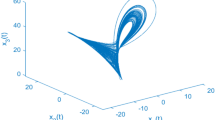Abstract
In this paper, we have constructed a new three-dimensional dynamical system and proposed a novel technique of synchronization to synchronize five drive systems with six response systems together. Motivated by compound combination synchronization and triple compound synchronization, we have extended the idea to triple compound combination synchronization of eleven chaotic systems. Suitable controllers have been constructed to obtain the desired synchronization between drive and response systems. For designing the nonlinear controllers, we used Lyapunov’s stability theory. Numerical simulations are done by using MATLAB, and graphs are presented to show the effectiveness of the proposed method.

















Similar content being viewed by others
Availability of data and materials
Not applicable.
Code Availability
Not applicable.
References
Azar AT, Vaidyanathan S (2015) Chaos modeling and control systems design, studies in computational intelligence, vol 581. Springer, New York
Azar AT, Vaidyanathan S (2015) Computational intelligence applications in modeling and control, vol 575. Studies in computational intelligence. Springer, New York
Chua LO, Itoh M, Kocarev L, Eckert K (1993) Chaos synchronization in Chua’s circuit. J Circuits Syst Comput 3(1):93–108
Yau HT, Pu YC, Li SC (2012) Application of a Chaotic synchronization system to secure communication. Inf Technol Control 41:274–282
Yeh JP, Wu KL (2008) A simple method to synchronize chaotic systems and its application to secure communications. Math Comput Model 47:894–902
Alsafasfeh QH, Arfoa AA (2011) Image encryption based on the general approach for multiple chaotic systems. J Signal Inf Process 2:238–244
Potapov AB, Ali MK (2001) Nonlinear dynamics and chaos in information processing neural networks. Differ Equ Dyn Syst 9:259–319
Upadhyay R, Rai V (2009) Complex dynamics and synchronization in two non-identical chaotic ecological systems. Chaos, Solutions Fractals 40(5):2233–2241
Laskin N (2000) Fractional market dynamics. Phys A Stat Mech Appl 287(3–4):482–492
Turcotte DL (1990) Implications of chaos, scale-invariance, and fractal statistics in geology. Glob Planet Chang 3(3):301–308
Gerig A, Hubler A (2007) Chaos in a one-dimensional compressible flow. Phys Rev E 75(4):045202
Lecar M, Franklin FA, Holman MJ, Murray NW (2001) Chaos in the solar system. Annu Rev Astron Astrophys 39(1):581–631
Pecora LM, Carroll TL (1990) Synchronization in chaotic systems. Phys Rev Lett 64:821–824
Yassen MT (2005) Chaos Synchronization between two different chaotic systems using active control. Chaos Solutions Fractals 23:131–140
Odibat ZM (2010) Adaptive feedback control and synchronization of non-identical chaotic fractional order systems. Nonlinear Dyn 60:479–487
Rakkiyappan R, Sivasamy R, Li X (2015) Synchronization of identical and nonidentical memristor-based chaotic systems via active backstepping control technique. Circuits Syst Signal Process 34:763–778
Hosseinnia SH, Ghaderi R, Ranjbar A, Mahmoudian M, Momani S (2010) Sliding mode synchronization of an uncertain fractional order chaotic system. Comput Math Appl 59:1637–1643
Guo Q, Wan F (2017) Complete synchronization of the global coupled dynamical network induced by Poisson noises. PLoS ONE 12:e0188632. https://doi.org/10.1371/journal.pone.0188632
Kim C, Rim S, Kye W, Ryu J, Park Y (2003) Anti-synchronization of chaotic oscillators. Phys Lett A 320(1):39–46. https://doi.org/10.1016/j.physleta.2003.10.051
Sudheer K, Sabir M (2009) Hybrid synchronization of hyperchaotic Lu system. Pramana 73(4):781–786. https://doi.org/10.1007/s12043-009-0145-1
Khan A, Khattar D, Agrawal N (2018) Hybrid projective synchronization between the fractional order systems. J Math Comput Sci 8(2):253–269
Ho M, Hung YC, Chou C (2002) Phase and anti-phase synchronization of two chaotic systems by using active control. Phys Lett A 296(1):43–48. https://doi.org/10.1016/S0375-9601(02)00074-9
Du H, Zeng Q, Wang C, Ling M (2010) Function projective synchronization in coupled chaotic systems. Nonlinear Anal Real World Appl 11(2):705–712. https://doi.org/10.1016/j.nonrwa.2009.01.016
Shahverdiev E, Sivaprakasam S, Shore K (2002) Lag synchronization in time-delayed systems. Phys Lett A 292(6):320–324. https://doi.org/10.1016/S0375-9601(01)00824-6
Liu Y, Davids P (2000) Dual synchronization of chaos. Phys Rev E 61(3):R2176. https://doi.org/10.1103/PhysRevE.61.R2176
Runzi L, Yinglan W, Shucheng D (2011) Combination synchronization of three classic chaotic systems using active backstepping design. Chaos Intersiscip J Nonlinear Sci 21(4):043114. https://doi.org/10.1063/1.3655366
Zhou X, Xiong L, Cai X (2014) Combination-combination synchronization of four nonlinear complex chaotic systems. Abstr Appl Anal. https://doi.org/10.1155/2014/953265
Sun J, Jiang S, Cui G, Wang Y (2016) Dual combination synchronization of six chaotic systems. J Comput Nonlinear Dyn 11(3):034501. https://doi.org/10.1115/1.4031676
Jahanzaib SJ, Trikha P, Chaudhary H, Haider SM (2020) Compound synchronization using disturbance observer based adaptive sliding mode control technique. J Math Comput Sci 10:1463–1480. https://doi.org/10.28919/jmcs/4637
Ojo KS, Njah AN, Olusola OI (2015) Compound-combination synchronization of chaos in identical and different orders chaotic systems. Arch Control Sci 25(4):463–490
Zhang B, Deng F (2014) Double-compound synchronization of six memristor-based Lorenz systems. Nonlinear Dyn 77(4):1519–1530. https://doi.org/10.1007/s11071-014-1396-z
Mahmoud G, Abed-Elhameed T, Farghaly A (2018) Double compound combination synchronization among eight n-dimensional chaotic systems. Chin Phys B 27(8):080502. https://doi.org/10.1088/1674-1056/27/8/080502
Yadav V, Prasad G, Srivastava M, Das S (2019) Triple compound synchronization among eight chaotic systems with external disturbances via nonlinear approach. Differ Equ Dyn Syst. https://doi.org/10.1007/s12591-019-00477-9
Wolf A, Swift JB, Swinney HL, Vastano JA (1985) Determining Lyapunov exponents from a time series. Phys D Nonlinear Phenom 16:285–317
Funding
Not applicable.
Author information
Authors and Affiliations
Contributions
A new chaotic system was introduced. A novel scheme of synchronization was proposed and named as triple compound combination synchronization.
Corresponding author
Ethics declarations
Conflict of interest
There is no conflict of interest between the authors.
Ethical approval
Not applicable.
Consent to participate
Not applicable.
Consent for publication
Not applicable.
Code availability
Not applicable.
Rights and permissions
Springer Nature or its licensor (e.g. a society or other partner) holds exclusive rights to this article under a publishing agreement with the author(s) or other rightsholder(s); author self-archiving of the accepted manuscript version of this article is solely governed by the terms of such publishing agreement and applicable law.
About this article
Cite this article
Khattar, D., Agrawal, N. & Singh, G. Triple compound combination synchronization of eleven n-dimensional chaotic systems. Int. J. Dynam. Control 11, 2499–2513 (2023). https://doi.org/10.1007/s40435-023-01140-6
Received:
Revised:
Accepted:
Published:
Issue Date:
DOI: https://doi.org/10.1007/s40435-023-01140-6
Keywords
- Chaos synchronization
- Combination synchronization
- Compound combination synchronization
- Lyapunov stability




